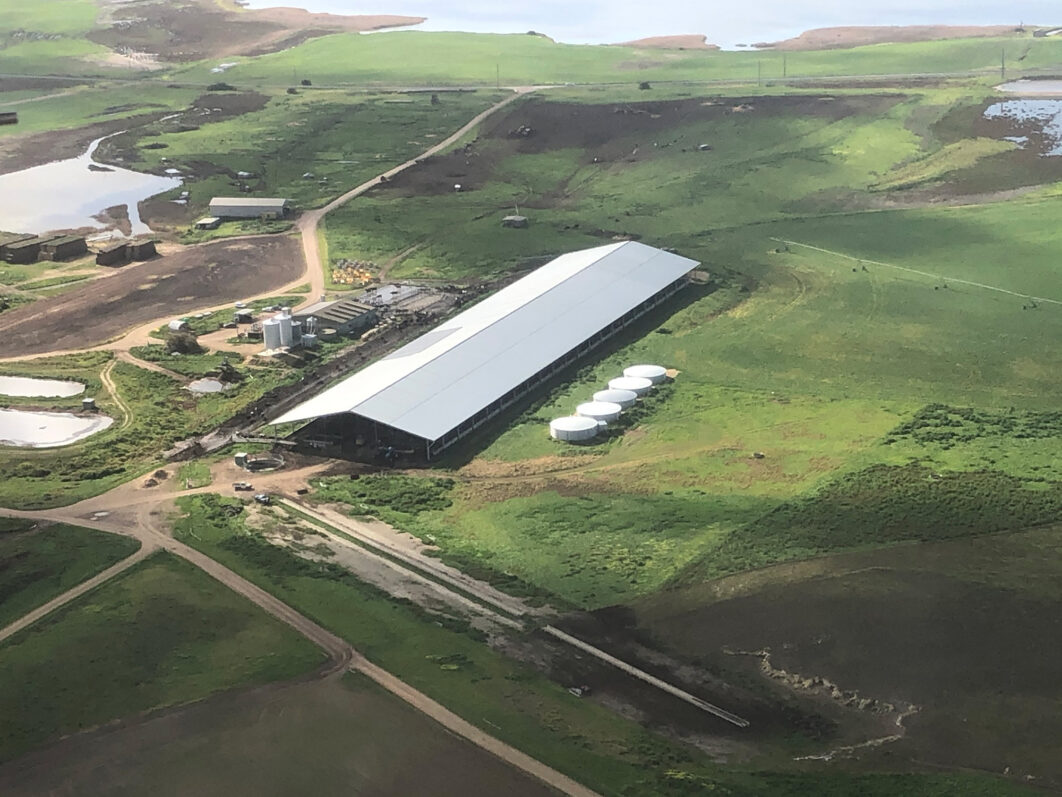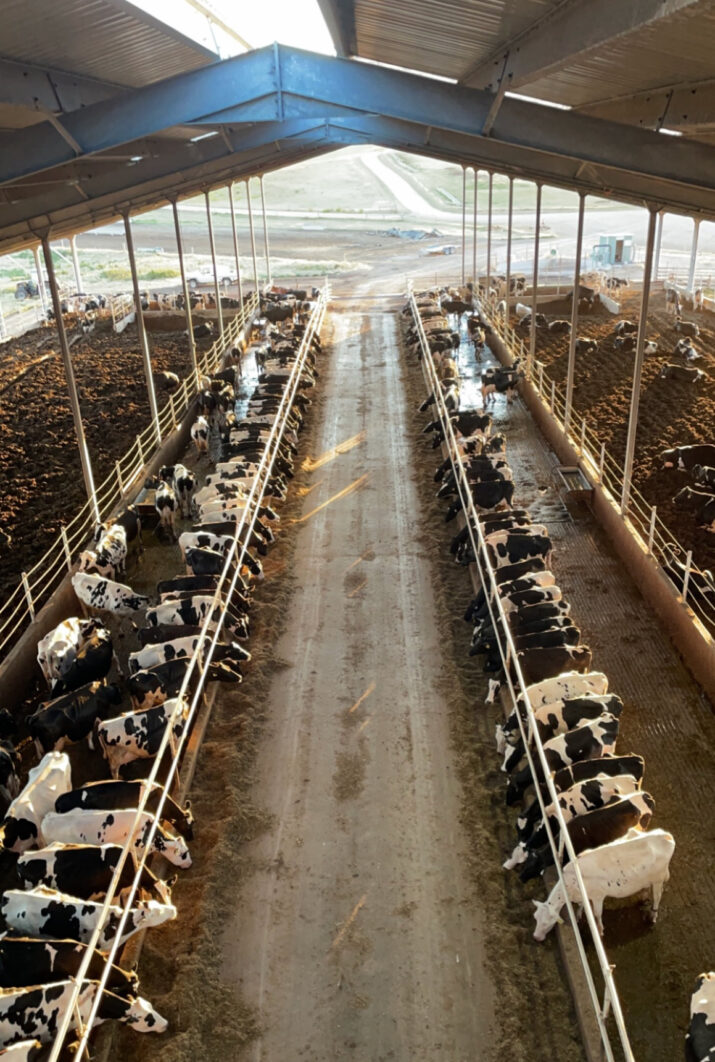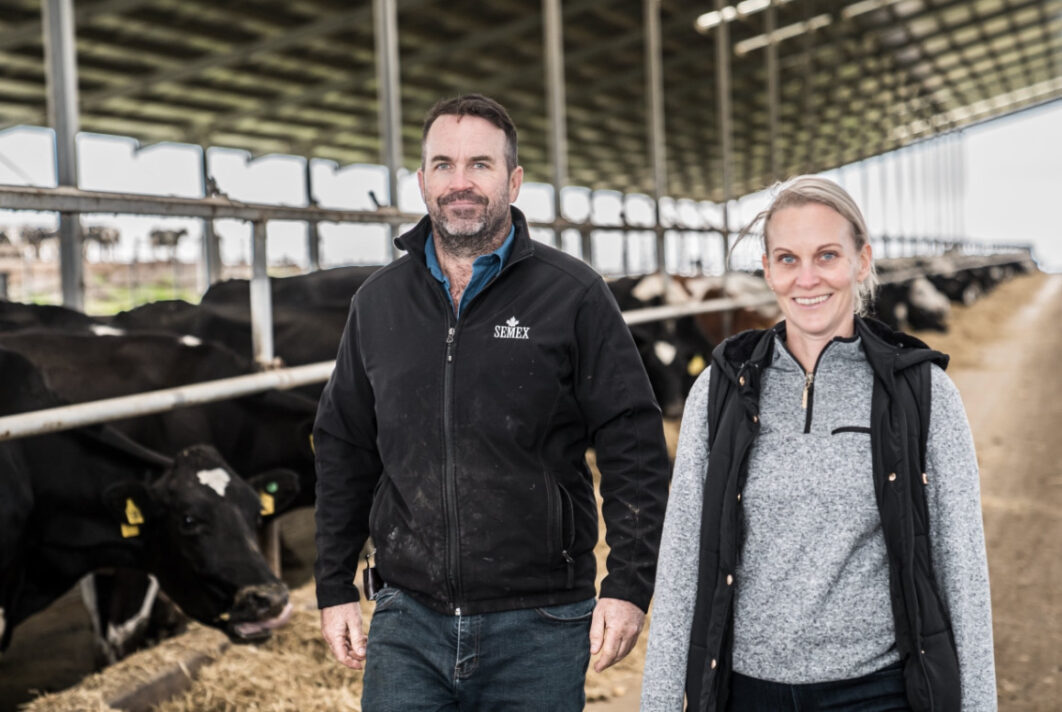Brad and Karin Fischer’s huge 220 x 53 metre barn-style dairy in Meningie is the biggest in South Australia, and one of a growing number of barn systems across Australia.
The total mixed ration (TMR) housed farming system is a climate controlled ‘palace’ for his 600 cows, that delivers significant benefits in cow health, milk quality and milk quantity.
Brad has spent $3 million on the barn system which he says gives him total control of the farm environment.
“It’s all about cow comfort, and it is no different to how any animals, including humans, want to live,” Brad said.
‘When it’s stinking hot outside, or when the wind is coming in sideways, or it’s cold and pouring with rain, you want to be inside, under shelter. The barn provides that and so much more.”
The barn consists of a confined feeding area, where cows have constant access to a balanced ration, a dairy area, where cows are milked two to three times a day, and a large bedding area – a thick mixed compost layer that provides comfort all year round.
Brad has been building up the compost layer for six years and it’s now 1.2m high. “It’s a layer of soft, fluffy compost and the cows love it,” he said.
“There are fans in there that keep the compost bedding area fresh. You go into the barn any time of the day, and some cows are lying flat out on their side. I sometimes have to give them a bit of a nudge to make sure they’re not dead!
“You go out there in the morning and they’re snoring. I’ve never seen that before in a paddock.”
Temperature
According to Dairy Australia’s ‘Cool Cows’ guide, cows experience stress when temperatures are above 25 degrees and below 5 degrees, and must use more energy to cool down or warm up, which decreases energy available for milk production.
“There’s a figure in that range which is a cow’s optimum temperature for producing milk,” Brad said. “The barn is temperature controlled to keep cows comfortable 24/7.
“Cows are 800 kilo animals, they’ve got a leather coat on, and they are all working hard to produce milk. They are little factories within themselves. And they have a lot of heat to get rid of on a normal day, let alone a hot day.
“So even though we’re all used to seeing cows out in paddocks, that’s often not the best place for them.”

Benefits
Jake Martin, from JGM Dairy Design Engineers, told a recent barn webinar that barn style dairies are effective, but the set-up cost must be justified.
“You are going from a sleeping bag in the middle of nowhere to the Hyatt Regency at a significant cost per cow,” Mr Martin said. “She (the cow) better have a damn good way of paying her own freight.”
For Brad Fischer, the main pay-off comes in the form of increased milk production and milk quality, with a list of high-quality processors wanting his product.
“We’ve been increasing milk production every year since we started in 2009. We’re now getting 11,000 litres per cow per year now,” he said.
According to Dairy Australia, the average annual milk production per cow in 2018/19 was 5,714 litres.
“Cows won’t produce milk to the level that you’d like them to if you force them to do it,” Brad said.
“This is all about cow comfort. Cow flow and cow comfort. We deliver the food to them in a balanced ration, and they’ve got access to food 24/7. There’s plenty of access to water. And they lay out comfortably for their sleeping in a climate-controlled shelter, with airflow. It’s an ideal environment for milk production.”
Brad has also invested in handheld automatic teat scrubbers, that wash, disinfect, dry and stimulate milk let-down before milking.
“Our incidence of mastitis has dropped significantly, and it simplifies the cupping job as well. Which keeps our staff happy. We want to make the job as easy as possible, as labour is a real challenge in the dairy industry, as it is everywhere.”
Between part-time and full-time staff, Brad has 18 employees.
History
Brad is the third generation of the Fischer family on the farm and came from a pasture based dairy background.
In 2001, he milked cows in Canada for 12 months, and then went to Sweden and worked in the dairy industry for two years, which is where he met his wife, Karin.
“Almost every dairy in Europe was a barn system and it was an eye opener,” Brad said.
“My mum and dad were big on genetics, so I knew we had the herd quality. And dad would spend hours out in tractors, ploughing, sowing and getting these beautiful pastures.
“But then the first 200 cows go out of the paddock and get the best feed. Then the second 200 cows go out and get average feed, and your cows that are in the back, who are normally the less dominant, potentially heifers, go out and get whatever they can find.
“But you want them all to do cracking production. They just can’t do it in a pasture system. And ryegrass or whatever you’re feeding your cows, it’s still not all that cow needs to produce milk.”
Brad spent several years researching the set up of a barn style in Australia before taking the plunge. He started by investing in a TMR feeding system, to give every cow the same quality and quantity of feed. He built the barn in 2016
“It was a big and expensive step, but we had this concrete feed pad delivering the feed to the cows, and everything worked well on a perfect day – when the weather was 17 degrees, with a bit of light breeze, but then in wintertime, there was always mud at their feet and then the food would get spoiled with rain or in the summertime it was too hot the cows just hated it.
“We were fully feeding our cows, but we weren’t fully controlling the environment that the cows were in, and in turn, the cows were unhappy. And keeping cows happy is what gets you consistent high-quality production.”

Milk quality
Brad has a long-standing friendship with Murray Bridge farmer, David Altmann, who is a business mentor to Brad and the duo works together on the marketing of their milk products.
“We knew we have great quality milk and volume, but we were frustrated with the milk price being offered by big companies, so we decided to look at some of the other options out there. We want our business to be here long-term, so looking at ways to diversify only seemed natural,” Brad said.
Between the two, they now supply seven different dairy companies – six of those producing high quality, niche dairy products.
“Supplying these boutique companies means our milk quality has to be spot on, as there’s nowhere to hide,” Brad said. “We’ve invested in significant technology such as milk meters and rumination collars to monitor cow health and pick up problems before they become a milk issue.
“When we first put the milk meters in eight years ago, we were picking up mastitis 24 hours prior to physically finding it. And now the rumination collars have given us another 24 to 36 hours of identifying mastitis before it’s a clinical case.”
